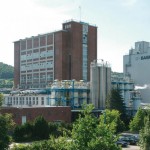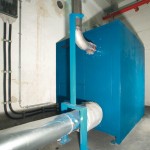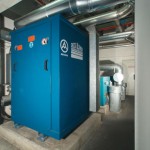Compressed air for pneumatic transport of granules and powdery material can only be produced efficiently and reliably if its production is customised to the application concerned. This is proven by two different supply concepts realised by a manufacturer of engineering plastics.
The author: Norbert Barlmeyer Freelance journalist
In Rudolstadt industrial park, about 35 km south of Weimar, BASF Performance Polymers GmbH has been producing polyamide granules as base material for compounds and for manufacturing composite films for foodstuff packings since 2003. The granules are subsequently processed into chemical products in several steps, in which they are melted, coloured, provided with aggregates, solidified and re-granulated. These products are used, amongst other things, for injection moulding as well as in automotive engineering, the electrical and electronics industry, sports equipment and leisure articles.
At BASF in Rudolstadt, compressed air plays a key role as a transport medium throughout the entire production process:
- First of all, the granules are conveyed pneumatically in a 450 m long piping system from production area 1 to production area 2.
- In production area 2 they are conveyed pneumatically from silos to packaging lines.
“We need different pressures for these transport tasks, which is why we work with custom-made production concepts in both areas”, foreman Stefan Ortschig emphasises.
In production area 1, the granules are initially charged from silos into a pipe via rotary valve feeders in a closed system and then transported pneumatically over a distance of 450 m to production area 2. There, they are separated from the conveying air in cyclone separators and stored again in silos prior to further processing. However, the conveying air that is purified in the cyclone separators is not lost. It is subsequently returned via a second pipe to production area 1, where it is re-fed into the circuit as conveying air.
Two oil-free compressing screw compressors made by Aerzener (type VM 10, flow capacity 9.2 m³/min) produce the required volume of conveying air for this task with a maximum pressure of 3.3 bar and continuously compensate any losses occurring in the system. A third, identical compressor is installed as a redundant unit. Operation alternates between the three compressors at regular intervals.
Open conveying system
Another – in this case open – pneumatic conveying system works in production area 2. The conveying air transports granules from silos to packaging lines via rotary valve feeders and weighing devices. For this pneumatic transport, however, a pressure of only 0.95 bar (minimum pressure 0.5 bar) is adequate. It is therefore not generated by screw compressors but by positive displacement blowers. Until 2007, three units with the following capacities – which had been operated in a network since 1992 – were available:
- One larger type GM 35 S unit with a constant delivery rate of 30 m³/min, and
- Two smaller type CMa11.2 units with a constant delivery rate of 6.2 m³/min each
The large unit was started up first whenever conveying air was requested. If this capacity proved to be insufficient, one of the small units was additionally connected by means of pres-sure switches with offset limits; if the air requirement was higher still, the second small unit was activated as well. Two out of the three conveying lines were supplied with this concept up until four years ago.
Advantages of two systems combined
In principle, this concept still exists today – but with one significant difference: in 2007, an additional Aerzener unit in the Delta Hybrid series (type G 13 S) was installed and immediately commissioned as more or less the sole supplier of conveying air. “Due to the far higher capacity of the rotary lobe compressor, namely 36 m³/min, we were able to supply all three conveyor lines with compressed air simultaneously for the first time since going operational with this unit”, reports production engineer Jörgfried Heise. Since being put into service in 2007, this unit has covered the needs of production area 2 virtually alone. Only in exceptional cases it is supported by one of the small units inherited from the old concept. Since we installed the new rotary lobe compressor, the old large blower is only used as a redundant unit or during maintenance work in order to guarantee a sufficient, uninterrupted supply of conveying air for operation around the clock.
The Delta Hybrid series features an interesting new design. In the past, only pressures up to 1 bar could be achieved with conventional positive displacement blowers. Above this value, screw compressors had to be used, even though the single-stage models are rated for considerably higher pressures of 2 or 3.5 bar. As a result, they are “much too good” for very low pressures from a technical point of view and therefore too expensive an investment. The new oil-free compressing units created a symbiosis that unites the advantages of both systems in an ideal way. A blower is better suited for lower pressures while a screw compressor tends to be preferred for high pressures. The rotary lobe compressors were designed for all applications where air and neutral gases have to be conveyed in the pressure range up to 1.5 bar, e. g. in sewage treatment plants, in the chemical industry or for transporting and unloading dusty products. Rotary lobe compressor units are available in the following performance classes:
- Volume flow: 10 to 70 m³/min
- Applications: Positive and negative air pressure
- Pressure range: 0 to 1.5 bar
- Suction range: Max. -0.7 bar
The units in this series not only consume up to 15 % less electrical power than was customary in the predecessor series. Amongst other things, they also deliver optimal value for money – with substantially lower capital, energy and maintenance costs than comparable turbo or screw compressors – and a high control range from 25 to 100 %.
Operation on demand
Like the old blower, the unit at BASF’s Rudolstadt plant was equipped with a frequency converter for variable-speed operation based on demand. It also operates continuously, however. The reason for this is the combination of a continuous transport cycle and a very short, clocked weighing cycle that works as follows: conveying air transports the granules in short cycles from a silo via a rotary valve to a pipe and then on to a scale. When the scale is full, the conveying process stops briefly and the contents are transported via a rotary valve and a piping system to the filling station. The scale filling process restarts at the same time. The advantages at a glance:
- The conveying air required to transport the granules from the scale to the filling station is continuously present as base load power
- The conveying air required to fill the scale is available intermittently as short-term peak load power with a clock cycle of just 20 s
Experience in Rudolstadt has shown that this required quantity – which fluctuates non-stop between a constant base load and very short-term peak loads – can be optimally covered with a single blower that executes continuous cycles and is aligned to the maximum requirement.
Hall 26, Booth E14
Online-Info: www.cpp-net.com/2111426
Share:









